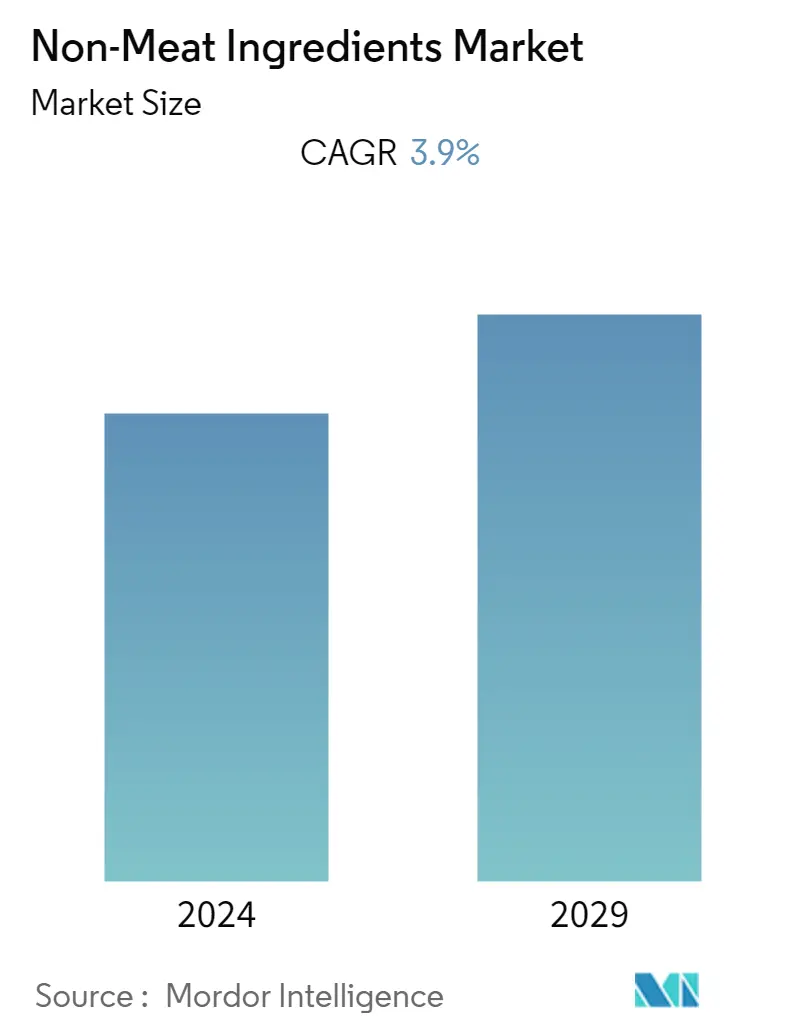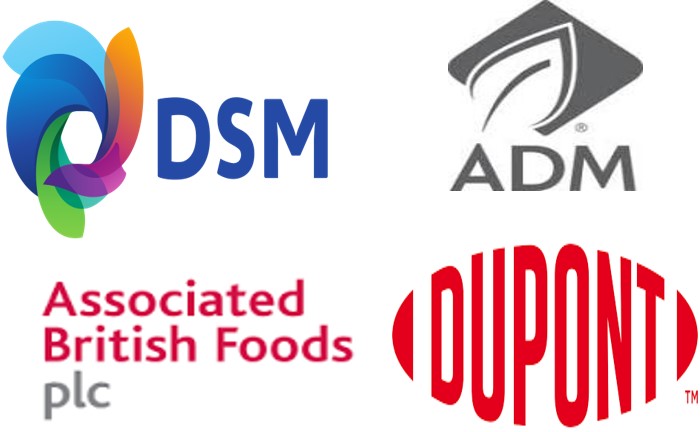Market Size of Non-Meat Ingredients Industry

| Study Period | 2019 - 2029 |
| Base Year For Estimation | 2023 |
| CAGR | 3.90 % |
| Fastest Growing Market | Asia Pacific |
| Largest Market | North America |
| Market Concentration | High |
Major Players
*Disclaimer: Major Players sorted in no particular order |
Non-Meat Ingredients Market Analysis
The global non-meat ingredients market is projected to register a CAGR of 3.9 during the forecast period (2020 - 2025)
- The rise of the paleo diet or the ‘caveman diet’ has also encouraged the consumption of lean meat and meat protein bars across the globe which in turn is accelerating the demand for non-meat ingredients from various food processing industries. For example, in 2016, General Mills acquired meat bar leader, Epic Bar to meet the growing meat snacks consumption across the globe as it perceived to be a healthier alternative by the consumers
- Additionally, startups, such as Omnibar, Kratos, and Caveman Foods, are introducing meaty bars of their own to meet the propelling demand, driving the sales of non-meat ingredients such as flavoring agents, binders, salts and others.
Non-Meat Ingredients Industry Segmentation
The global non-meat ingredients market includes ingredients such asbinders, fillers, extenders, coloring agents flavoring agents, preserving agents, texturing agents, and salts.Furthermore, the report provides an analysis of the meat ingredients market in the emerging and established regions, including North America, Europe, South America, Asia-Pacific, and Middle East & Africa.It also includes an analysis of the major players in the market, and their strategies and recent developments.
| By Ingredient | |
| Binders | |
| Extenders | |
| Fillers | |
| Flavoring Agents | |
| Coloring Agents | |
| Preservatives | |
| Salt | |
| Texturing Agents |
| By Product Type | |
| Fresh Processed | |
| Raw Cooked | |
| Pre Cooked | |
| Raw Fermented Sausages | |
| Others |
| Geography | ||||||||
| ||||||||
| ||||||||
| ||||||||
| ||||||||
|
Non-Meat Ingredients Market Size Summary
The global non-meat ingredients market is experiencing a notable expansion, driven by the increasing popularity of diets such as the paleo diet, which emphasizes lean meat and meat protein bars. This trend has spurred demand for non-meat ingredients across various food processing sectors, as companies like General Mills have strategically acquired brands like Epic Bar to capitalize on the growing consumption of meat snacks. Startups such as Omnibar, Kratos, and Caveman Foods are also contributing to this growth by introducing their own meaty bars, which require a range of non-meat ingredients including flavoring agents, binders, and salts. The rise of snack culture has further propelled the consumption of meat snacks, positioning them as healthier alternatives to traditional snacks. Meat protein bars, in particular, are gaining traction as consumers increasingly view meat as a natural protein source, with lean meat options being particularly popular among millennials.
In North America, where per capita meat consumption is high, the demand for non-meat ingredients is significantly influenced by consumer preferences for flavorful, nutritious, and safe food options. The market is characterized by a competitive yet fragmented structure, with major global players holding significant market positions due to brand loyalty. The clean-label trend, driven by food safety concerns, has led to a preference for natural ingredients, further boosting the market. Key players are focusing on product innovation and regional flavor experimentation, while also expanding their distribution networks and forming partnerships in emerging economies. This strategic approach is helping them maintain a competitive edge and cater to the diverse needs of different end-user industries.
Non-Meat Ingredients Market Size - Table of Contents
-
1. MARKET DYNAMICS
-
1.1 Market Drivers
-
1.2 Market Restraints
-
1.3 Porter's Five Forces Analysis
-
1.3.1 Threat of New Entrants
-
1.3.2 Bargaining Power of Buyers/Consumers
-
1.3.3 Bargaining Power of Suppliers
-
1.3.4 Threat of Substitute Products
-
1.3.5 Intensity of Competitive Rivalry
-
-
-
2. MARKET SEGMENTATION
-
2.1 By Ingredient
-
2.1.1 Binders
-
2.1.2 Extenders
-
2.1.3 Fillers
-
2.1.4 Flavoring Agents
-
2.1.5 Coloring Agents
-
2.1.6 Preservatives
-
2.1.7 Salt
-
2.1.8 Texturing Agents
-
-
2.2 By Product Type
-
2.2.1 Fresh Processed
-
2.2.2 Raw Cooked
-
2.2.3 Pre Cooked
-
2.2.4 Raw Fermented Sausages
-
2.2.5 Others
-
-
2.3 Geography
-
2.3.1 North America
-
2.3.1.1 United States
-
2.3.1.2 Canada
-
2.3.1.3 Mexico
-
2.3.1.4 Rest of North America
-
-
2.3.2 Europe
-
2.3.2.1 Spain
-
2.3.2.2 United Kingdom
-
2.3.2.3 Germany
-
2.3.2.4 France
-
2.3.2.5 Italy
-
2.3.2.6 Rest of Europe
-
-
2.3.3 Asia Pacific
-
2.3.3.1 China
-
2.3.3.2 Japan
-
2.3.3.3 India
-
2.3.3.4 Australia
-
2.3.3.5 Rest of Asia-Pacific
-
-
2.3.4 Rest of the World
-
2.3.4.1 Brazil
-
2.3.4.2 Argentina
-
2.3.4.3 Others
-
-
2.3.5 Middle East & Africa
-
2.3.5.1 South Africa
-
2.3.5.2 Saudi Arabia
-
2.3.5.3 Rest of Middle East & Africa
-
-
-
Non-Meat Ingredients Market Size FAQs
What is the current Non-Meat Ingredients Market size?
The Non-Meat Ingredients Market is projected to register a CAGR of 3.9% during the forecast period (2024-2029)
Who are the key players in Non-Meat Ingredients Market?
DuPont de Nemours Inc, Associated British Foods PLC, Archer Daniels Midland Company, Koninklijke Dsm N.V and BASF SE are the major companies operating in the Non-Meat Ingredients Market.

